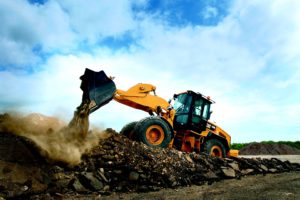Blocking Raised Equipment Safety Talk

WHAT’S THE DANGER?
Every year workers die or are critically injured because the equipment they are working on does not have adequate blocking installed. In addition to properly locking out control mechanisms, it is critical to block all forms of hazardous energy including: potential energy due to gravity, hydraulic pressure, or any stored energy that may cause equipment to move or drift, such as electrical or mechanical energy. The lack of blocking allows equipment to move or drop, striking workers, which could lead to fatal and critical injuries.
These Events Involve:
- raised blades of bulldozers;
- raised buckets of backhoes;
- raised boxes of dump trucks;
- raised forks of forklifts;
- punch presses;
- hoisting equipment.
More Danger
Unless you have ensured that raised equipment cannot move by securely blocking movement, the potential for collapse is very great. In the majority of incidents where equipment has unexpectedly come down, the person under it had no time to react and escape – it happens faster than you can move. The equipment can come down for a variety of reasons, including soft ground not being able to support the base of a jack or small block; an inadvertent release of hydraulic pressure by someone touching the control or loosening a fitting; to the person under the equipment pulling on a tool causing the equipment to move on its inadequate blocking.
Even if you just have to go under or in between raised components for a minute, it will take far less time to block the raised equipment securely compared to the time it will take to recover from the injuries or arrange a funeral.
EXAMPLES
- A worker was repairing a front-end loader with the bucket raised but without following LOTO procedures and without putting blocking on the hydraulic arms of the bucket. The hydraulics start to lose pressure and the bucket falls to the ground and fatally crushes the worker.
- A by-stander is struck and receives disabling injuries after a delivery driver failed to properly chock the wheels on the truck.
When one does not practice chocking and blocking, the above can occur.
HOW TO PROTECT YOURSELF
The Occupational Health and Safety Act require that all Ontario employers, regardless of the type of work, take every precaution reasonable in the circumstances and provide information, instruction and supervision to a worker to protect the worker’s health and safety.
Given the seriousness of this hazard, it is advisable to have in place an additional control such as connecting the blocking to a mechanical, electrical or other type of device (interlock) that causes the power to be shut off until the block is removed and the power reactivated manually.
It is also important that safety-blocking devices are rated to support the total weight of the equipment components they are used to support. They should also display the permitted tonnage for workers to reference and must be able to bridge the entire vertical space they are blocking to prevent any hazardous movement.
Blocking
Blocking is the act of using lumber to keep cargo in place. Blocking stabilizes cargo to prevent shifting and trailer overturns. Blocking also creates a physical barrier on equipment to prevent unintentional activation during maintenance.
- Block cargo to prevent loads from shifting during transport and unloading. If you don’t, a sudden shift in the center of gravity can overturn a trailer and unstable loads can strike, crush, or engulf workers when the materials are unloaded.
- Get in the practice of blocking all cargo – not just wheeled or round items.
- Items should be blocked separately and on all four sides with lumber and nails or spikes thick enough and long enough to keep the cargo in place.
- Drive nails or spikes into the lumber at opposing angles.
- Never use other cargo for blocking— it doesn’t prevent movement in the same way a block can and may cause your cargo to overturn.
- Keep your hands, fingers, and the rest of your body out of dangerous pinch points.
More Safety and Blocking Procedures
Seven Important Do’s
- Review the complete Standard Operating Practices for every year or at the start of the season when you will be using this type of equipment.
- Machines and equipment should be supported with the manufacturer’s safety bracing system. If it is not available use solid wood blocking on solid work surfaces according to the manufacturer’s instructions.
- Block both sides of wheels on partially raised farm equipment with trailing wheels.
- Turn off tractor engine and set brakes during maintenance work, unless otherwise indicated by manufacturer.
- Freight should be blocked when loading or unloading a trailer. Do not use other freight as a block. Use proper materials for blocking.
- Use larger blocks on the bottom. Make the platform as wide as possible.
- Double-up and alternate the positioning of blocks while building a platform.
One Important Don’t
- Don’t rely on jacks, hoists or hydraulic systems to support raised equipment. They are made to lift, not to support. The equipment should be blocked to support it while you are working on it.
FINAL WORD
Chocking and blocking are good practices to prevent heavy loads and vehicles from unintentionally moving. If you are loading or unloading, hitching or unhitching, or performing maintenance on a vehicle, you must take time to chock and block the equipment to protect you and others from unintended movement of the equipment and/or cargo.